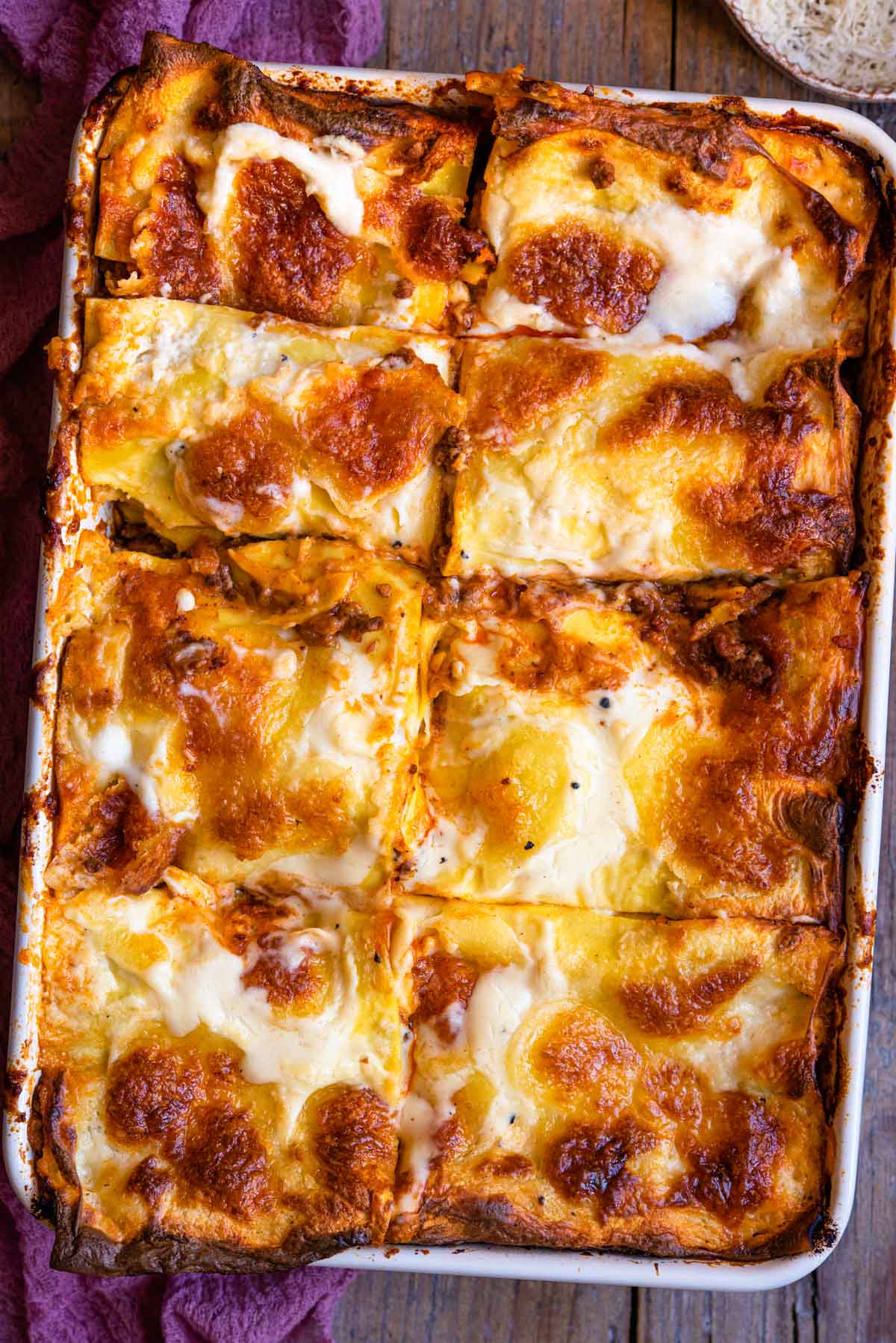This post may contain affiliate links. Please read our disclosure policy.
A classic recipe for homemade Lasagne al Forno (Italian Beef Lasagna) made entirely from scratch. There’s truly nothing more comforting than a hot bubbling baked lasagna made with homemade beef ragu, bechamel sauce, silky pasta and topped with melted mozzarella cheese! This traditional Italian recipe will be a comfort food favourite.

Lasagne al Forno is the perfect meal for Sunday dinner, the rich beef ragu can simmer away while you prepare the bechamel sauce and if you feel like going all out you can even make homemade pasta too.
It’s truly special.
Is Lasagne Hard to Make?
So here’s the thing, lasagne may seem daunting to make from scratch but it’s not difficult! Here’s a breakdown of the elements;
- Ragu or meat sauce – the beef ragu takes around 10-15 minutes to prep (cutting the veg, browning the meat etc) but once you’ve done that you leave it to simmer away for a few hours while you get on with your day, easy!
- Pasta – if you’re making homemade pasta then the prep time is increased significantly which is fine if you’re having a fun day of cooking but if you want as less prep as possible then use pre-bought fresh lasagna sheets/noodles. You can use dried but I recommend using fresh, see my notes below on why.
- Bechamel sauce – this lasagna is a traditional Italian version so it’s made with bechamel sauce and NOT ricotta cheese. You’ll see ricotta used in Italian-American recipes. Don’t worry though making a bechamel sauce from scratch takes no more than 10 mins and it can be prepped in advance or just before you are ready to assemble the dish.
- Assembling the dish – this is the fun part and takes around 10 minutes (if that). Just layer up the pasta, ragu, bechamel and top with cheese, simple!
- Cooking the lasagne – it takes around 45 minutes to bake in the oven so you can see why from start to finish it takes a pretty long time but all that time is not spent in the kitchen. Once you’ve made this from scratch using all our tips you won’t believe how simple it is!

Pin this now to find it later
Pin ItFun Fact – The Difference between Lasagna and Lasagne
For the proper foodies that are curious about the different spellings, it’s actually very simple.
So in Italian, lasagna is one sheet of pasta or noodle and lasagne is more than one (plural).
Because this pasta dish is made with more than one lasagna noodle it’s referred to as lasagne or Lasagne al Forno in Italian but the whole dish is often known as lasagna everywhere else in the world.
Whatever way you call it we are all talking about the same bubbling beautiful thing!
How to Make Lasagne al Forno – Step by Step
Il Soffritto
The ragu starts like a lot of Italian sauces, stews and soups, with Il Soffritto.
Il Soffritto is very simply, finely chopped carrot, celery and white onion sauteed slowly with a little olive oil for about 10 minutes until soft.
This adds incredible depth of flavour to many dishes and can even be made in advance to add into weeknight meals for an extra flavour punch.
Top Tip: Make a big batch and freeze it, you can cook it straight from frozen!
How to Make the Ragu
Finely chop the carrot, celery and onion and sweat slowly with a little olive oil in a large, deep skillet or pan (photo 1).
Once you’ve sauteed the veggies, add the meat and brown whilst breaking it up with a wooden spoon (photos 2).

Add the red wine and reduce by half. Once the wine has reduced, add the sieved tomatoes, tomato paste, bay leaf, 4 cups of the beef stock and a pinch of salt and pepper. Stir everything together and leave to simmer on a low heat for 2.5-3 hours uncovered. Add the rest of the beef stock half way through (photos 3-6).
How to Make Bechamel Sauce
Add the butter to a saucepan and cook until melted and bubbling (photo 7).
Add the flour to the melted butter and stir to form a paste. Let the flour cook for 1 minute (photo 8).

Slowly whisk half of the milk into the butter and flour constantly whisking to avoid any lumps. Once it has started to thicken add the rest of the milk, nutmeg, parmesan and a pinch of salt and pepper (photos 9-11).
Continue to heat the sauce whilst stirring until thickened enough to coat the back of a wooden spoon. Take off the heat and set aside (photo 12).
How to Assemble the Lasagne
To assemble the lasagne, spoon a small amount of ragu on the very bottom of the baking dish. Top with and even layer of lasagna pasta sheets (photos 13 & 14).
Add a few more spoons of ragu so the pasta is completely covered followed by white sauce (photos 15-16).

Repeat the layers of pasta, ragu and bechamel sauce finishing with a layer of pasta topped with bechamel sauce (you should have 4-5 layers of pasta). Cover the top layer of the lasagne with torn mozzarella and then bake in the oven until bubbling and golden (photos 17 & 18).
Dried Vs Fresh Lasagna Sheets
When making lasagne I always use fresh lasagna sheets or make my own homemade pasta if I have time.
Fresh lasagna sheets have a much nicer texture than dried and it saves time having to pre-boil them.
I also find that dried lasagna sheets curl up as they cook so you don’t get a nice defined layer.
Top Tips for Making Lasagne al Forno
- The ragu needs at least 3 hours to simmer and there’s a reason for that, the flavour is incredible and you just won’t get the same depth of flavour by turning the heat up or using any shortcuts.
- Don’t cover the ragu as it’s simmering or it won’t concentrate in flavour enough. If you find the ragu has reduced and thickened too much add more water 1/2 cup (125ml) at a time.
- You can make the beef ragu a day or two in advance to cut the prep time down.
- I also recommend freezing beef ragu so you can thaw it overnight before making lasagne.
- I only use parmesan in the white sauce but to make it extra indulgent you can add a good strong melting cheese such as gruyere or fontina.
- If you want to make your own pasta then check out our Homemade Pasta Dough recipe.
- Does your lasagna collapse on your plate? that means you’ve not reduced the ragu enough. Check out the video and step by step photos for reference of how your ragu and bechamel sauce should look.
- If you want to use dried lasagna sheets then follow the packet instructions to see if you need to pre-boil them.

Other Lasagna Recipes You Might Like;
- Eggplant Lasagna with Prosciutto and Mozzarella
- Butternut Squash Lasagna – Sage, Prosciutto & Goats Cheese
- Lentil Ragu Lasagne
If you’ve tried this Classic Beef Lasagne or any other recipe on the blog then don’t forget to rate the recipe and let me know how you got on in the comments below, I love hearing from you! You can also FOLLOW ME on FACEBOOK, INSTAGRAM and PINTEREST to see more delicious food and what I’m getting up to.
Step By Step Photos Above
Most of our recipes come with step by step photos, helpful tips and tricks to make it perfectly first time and even video!
Lasagne al Forno (Italian Beef Lasagna)

Equipment
- 9×13 inch baking dish
Ingredients
Ragu
- 1 tbsp olive oil
- 1 cup carrot, finely chopped (1 large)
- 1 cup stalk celery, finely chopped (1 large)
- 1 cup white onion, finely chopped (1 large)
- 1 lb ground beef (mince), (500g)
- 1 lb ground pork (mince), (500g)
- 2.5 cups Passata (tomato puree US), (540g)
- 3 tbsp tomato paste
- 1 cups red wine, (250ml)
- 6 cups beef stock, (1.5 litres)
- 2 bay leaves
- 1 tsp sea salt flakes and pepper
White Sauce
- 5 tbsp butter, (70g)
- 5 tbsp flour all-purpose, (70g)
- 4 cups full fat milk, (1 litre)
- 1/2 tsp nutmeg
- 1 cup parmesan, freshly grated (70g)
- 1 tsp sea salt salt and pepper, or to taste
Lasagne
- 1 lb fresh lasagna pasta sheets, (17 oz/500g)
- 2 balls mozzarella, (8 oz/250g)
Instructions
Ragu
- Finely chop the carrot, onion and celery and saute the vegetables gently in a large frying pan with the olive oil. Once the vegetables are soft add the beef and pork mince and cook until browned.
- If there is a lot of excess fat in the pan, spoon some out. Add the red wine and reduce by half.
- Once the wine has reduced, add the passata (tomato puree), tomato paste, bay leaves, 4 cups of beef stock (1 litre) and a pinch of salt and pepper.
- Stir everything together and leave to simmer on a low heat for 2.5-3 hours uncovered. Add the rest of the beef stock half way through.
White Sauce
- Add the butter to a saucepan and cook until melted and bubbling.
- Add the flour to the melted butter and stir to form a paste. Let the flour cook for 1 minute.
- Slowly whisk half of the milk into the butter and flour constantly whisking to avoid any lumps. Once it has started to thicken add the rest of the milk, nutmeg, parmesan and a pinch of salt and pepper.
- Continue to heat the sauce whilst stirring until thickened enough to coat the back of a wooden spoon. Take off the heat and set aside.
Assemble the lasagne
- Preheat the oven to 350F (180C).
- To assemble the lasagne, spoon a small amount of ragu on the very bottom of the baking dish. Top with and even layer of lasagna pasta sheets (cut the pasta sheets to fit your baking dish).
- Add a few more spoons of ragu so the pasta is completely covered followed by 2 ladels of white sauce.
- Repeat the layers of pasta, ragu and bechamel sauce until everything is used up making sure to keep enough of bechamel sauce for the very top layer (you should have 4-5 layers of pasta).
- Cover the top layer of the lasagne with torn mozzarella and then bake in the oven for 45minutes or until bubbling and golden.
- Let it cool slightly for 5-10 minutes before serving.
Video
Notes
- Cook time – The ragu needs at least 3 hours to simmer and there’s a reason for that, the flavour is incredible and you just won’t get the same depth of flavour by turning the heat up or using any shortcuts.
- Don’t cover the ragu as it’s simmering or it won’t concentrate in flavour enough. If you find the ragu has reduced and thickened too much add more water 1/2 cup (125ml) at a time.
- Prep in advance – You can make the beef ragu a day or two in advance to cut the prep time down.
- Freezing – I also recommend freezing beef ragu so you can thaw it overnight before making lasagne.
- White sauce – I only use parmesan in the white sauce but to make it extra indulgent you can add a good strong melting cheese such as gruyere or fontina.
- If you want to make your own pasta then check out our Homemade Pasta Dough recipe.
- Does your lasagna collapse on your plate? that means you’ve not reduced the ragu enough. Check out the video and step by step photos for reference of how your ragu and bechamel sauce should look.
- Dried pasta – If you want to use dried lasagna sheets then follow the packet instructions to see if you need to pre-boil them.
- Love this recipe? You’ll also want to try our Authentic Lasagna Bolognese recipe.
Helpful Info for All Recipes
- I always use extra virgin olive oil in all of my recipes unless stated otherwise
- When I use canned or jarred tomatoes of any kind I always use Cirio or Mutti brands for the best results and flavour.
- All vegetables are medium sized unless stated otherwise
- All recipes are tested and developed using a fan (convection) oven
- Find out more about how nutrition is calculated.
- Check out our must have Italian Pantry Staples.
- You can also find all our Essential Kitchen Tools for Italian Cooking.
Nutrition
Nutrition information is automatically calculated, so should only be used as an approximation.
















Superb rich flavour. Well worth taking the time to make the ragu. Best lasagna I’ve ever eaten. Five stars without hesitation.
Grazie infinite !! I have tried various lasagne recipes over the years and this one is by far the stand out winner of all time. My family couldn’t get enough – bravo. The moment this lasagne came out of the oven it looked perfect, as if prepared by a Michelin-Starred Chef which I’m not – just a home cook. And the taste more than matched the look of the lasagne. This lasagne is fantastico – buonissimo. Allan
Fantastic recipe – best lasagne I’ve had in years. Flavourful and maybe even slightly decadent!! I messed up a little (wasn’t paying attention) and added 500ml too much stock, so had to increase the reduction time quite a lot, but it doesn’t seem to have done it any harm!
This is the best recipe ever!!! Yum
Loved it but mine was runny. My bechamel was a little runny. It didn’t look stiff like yours. Is it because I used it while it was still warm? thanks!
Although bechamel does thicken a little more when it cools it should still thicken well while warm. I would turn the heat up and cook it for longer whilst whisking until it thickens more. It could be that there wasn’t enough flour so you could add a touch more next time (it should be equal quantities of flour and butter by weight). Hope that helps, Emily.
If using home made pasta sheets, do they need to be cooked/boiled prior to assembly? In your writeup you mention buying fresh pasta sheets and not having to boil but I am unclear if I need to when making the pasta myself.
Thank you! Looking forward to this on Easter!
Hi Tris, if you’re using fresh pasta sheets you don’t need to boil them first but I prefer the texture/taste if they are boiled first (around 10-20 seconds). It’s an extra step but worth it in my opinion! Hope you enjoy it! Emily
Do i need to warm the milk before i make the béchamel sauce? if so, to how hot?
thanks
Hi Martin, yes, you can warm the milk first and the bechamel will thicken a lot quicker. You don’t need it boiling—just warm it gently until it’s hot but not simmering. You can also do it with cold milk (I’ve done it both ways many times) and that’s fine too 🙂
I made this yesterday for first tine. Followed directions to the t, but my ragu was very liquidy I
Spooned out liquid from after i browned the pork and beef. What did I do wrong? I did use a ladle with holes to assemble the lasagna which helped. Lasagna was good! Love your recipes by the way. We were stationed in Italy in the early 70’s
I made this for me and my boyfriend yesterday, and he said it’s probably the best lasagna he’s ever had! Will definitely only be using this recipe from now on 😄